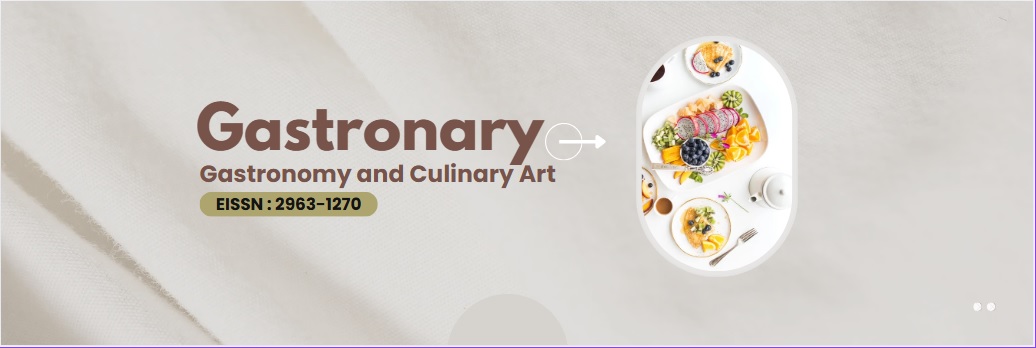Consumer Response Analysis to Food Quality of Fermented Cassava Ice Cream
Keywords:
Fermented Cassava, Hedonic Test, Ice Cream, Organoleptic TestAbstract
Ice cream is a frozen product made from processed milk, cream, and a combination of various ingredients that are liked by various groups. Ice cream is proven to have some unexpected nutritional facts. The advantages of ice cream are supported by its main ingredients, namely nonfat milk and milk fat. Meanwhile, cassava tape results from cassava fermentation by yeast which contains mould, yeast, lactic acid bacteria, and amylolytic bacteria. This research is an experimental type that aims to analyze people's preference for cassava tape ice cream quality based on aspects of colour, appearance, texture, aroma, and taste, tested on 34 respondents. The analytical method used was the hedonic test with a Likert scale with 4 levels (Like, Like, Like, Dislike, Really Dislike) through questionnaires and organoleptic tests through short interviews with 3 respondents on each aspect. The results showed that through the hedonic test, the colour aspect was very liked with a value of 3.97, the appearance aspect was very liked with a value of 3.94, the texture aspect was very liked with a value of 3.88, the aroma aspect was very liked with a value of 3.47, and the taste aspect gets the very like category with a value of 3.50. Meanwhile, through the organoleptic test, the 3 respondents in each aspect liked all the aspects tested. Based on the study's results, it can be concluded that tape cassava ice cream is liked by respondents based on aspects of colour, appearance, texture, aroma, and taste.
References
Arikunto, S. (2010). Metode peneltian. Jakarta: Rineka Cipta.
Asashi, T., & Sukaatmadja, I. P. G. (2017). Peran inovasi produk dalam memediasi pengaruh orientasi pasar terhadap kinerja pemasaran. E-Jurnal Manajemen Universitas Udayana, 6(4), 1816-1845. URL https://garuda.kemdikbud.go.id/documents/detail/1369453
Asri, A., Minu, I. W., Riska, R., & Rahmat, R. (2021). Fermentasi Tape dan Minas dalam Perspektif Hukum Islam. BUSTANUL FUQAHA: Jurnal Bidang Hukum Islam, 2(2), 232-250. https://doi.org/10.36701/bustanul.v2i2.378
Badarudin, M. I. (2019). Pengolahan cemilan stick rumput laut (Eucheuma Cottoni) dengan konsentrasi tepung terigu berdasarkan nilai organoleptik. Jurnal Riset Perikanan dan Kelautan, 1(1), 14-25. URL http://ejournal.um-sorong.ac.id/index.php/jrpk/article/view/507
Isnendes, C. R. (2013). Peuyeum Bandung makanan tradisional yang terkenal (folklor bukan lisan dari Jawa Barat). Konferensi Internasional Folklor Asia .
Kanino, D. (2019). Pengaruh Konsentrasi Ragi Pada Pembuatan Tape Ketan (The Effect Of Yeast Concentration On Making Tape Ketan). Jurnal Penelitian dan Pengembangan Agrokompleks, 64-74. URL https://journal.unhas.ac.id/index.php/jppa/article/view/6545
Kusuma, T. S., Kurniawati, A. D., Rahmi, Y., Rusdan, I. H., & Widyanto, R. M. (2017). Pengawasan Mutu Makanan. Universitas Brawijaya Press.
Marsetyo, M. (2010). The effect of gliricidia or mixture of rice bran and copra meal supplementation on feed intake, digestibility and live weight gain of early weaned Bali calves fed a Mulato grass. In International Seminar on Tropical Animal Production (ISTAP) (pp. 183-188). URL https://journal.ugm.ac.id/istapproceeding/article/view/30454/18369
Marminah, M. (2012). Perbedaan Kadar Protein Tape Singkong (Manihot utilisima) Biasa Dengan Yang Diberi Penambahan Sari Buah Nanas (Ananas comosus) (Doctoral dissertation, Universitas Muhammadiyah Surakrta).
Novia, C., Syaiful, S., Syafiih, M., & Utomo, D. (2018). Peningkatan Pendapatan Masyarakat Melalui Diversifikasi Olahan Tape Singkong. Teknologi Pangan: Media Informasi Dan Komunikasi Ilmiah Teknologi Pertanian, 9(2), 164-168. https://doi.org/10.35891/tp.v9i2.1197
Novianti, S. (2017). Penggunaan Air Rebusan Kacang Merah Sebagai Substitusi Putih Telur (Aquafaba) Dalam Pembuatan French Meringue: Pendekatan Organoleptik. Barista: Jurnal Kajian Bahasa dan Pariwisata, 4(2), 207-223. URL https://journal.stp-bandung.ac.id/index.php/barista/article/view/151/77
Nugroho, Y. A., & Kusnadi, J. (2014). Aplikasi Kulit Manggis (Garcinia Mangostana L.) Sebagai Sumber Antioksidan Pada Es Krim [In Press September 2015]. Jurnal Pangan dan Agroindustri, 3(4). https://jpa.ub.ac.id/index.php/jpa/article/view/249
Purnomo, F. A. (2019). Inovasi Produk Baju Anak Perempuan Bonne Chance. Agora, 7(1). URL https://publication.petra.ac.id/index.php/manajemen-bisnis/article/view/7811/7042
Rachman, A. B. (2017). Tingkat Penggunaan Santan Kelapa dan Tepung Ubi Hutan (Dioscorea hispida dennts) pada Pembuatan Es Krim. ARTIKEL, 1(686). URL https://repository.ung.ac.id/en/karyailmiah/show/686/tingkat-penggunaan-santan-kelapa-dan-tepung-ubi-hutan-dioscorea-hispida-dennts-pada-pembuatan-es-krim.html
Setiawan, M. F. (2013). Analisa pengaruh food quality dan brand image terhadap keputusan pembelian roti kecik toko roti Ganep’s di Kota Solo. Jurnal Strategi Pemasaran, 1(1). URL https://publication.petra.ac.id/index.php/manajemen-pemasaran/article/view/72
Sugiyono. (2019). Metode penelitian pendekatan kuantitatif, kualitatif dan R&D.
Trisnawati, W., Suter, K., Suastika, K., & Putra, N. K. (2014). Pengaruh metode pengeringan terhadap kandungan antioksidan, serat pangan dan komposisi gizi tepung labu kuning. Jurnal Aplikasi Teknologi Pangan, 3(4). URL http://www.jatp.ift.or.id/index.php/jatp/article/view/107
Downloads
Published
How to Cite
Issue
Section
Categories
License

This work is licensed under a Creative Commons Attribution-ShareAlike 4.0 International License.






